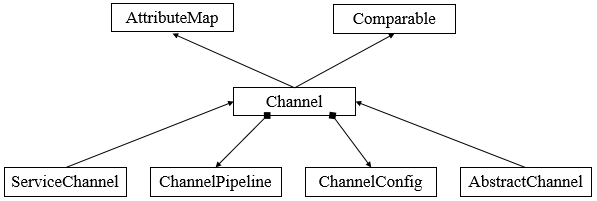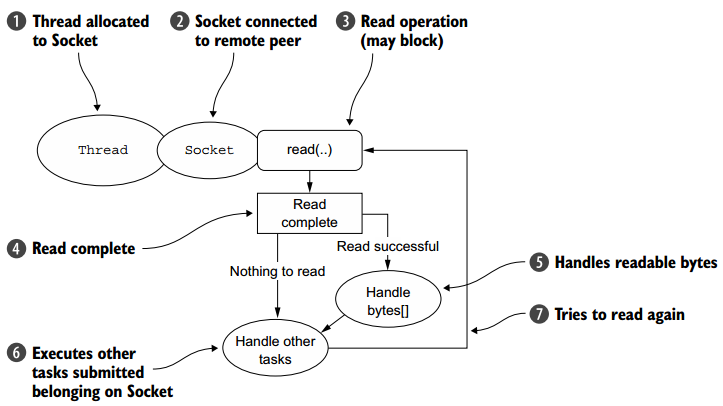【Netty】Netty传输
一、前言
在简单学习了Netty中的组件后,接着学习Netty中数据的传输细节。
二、传输
2.1 传输示例
Netty中的数据传输都是使用的字节类型,下面通过一个实例进行说明,该实例中服务器接受请求,然后向客户端发送一个Hi,最后关闭连接。下面是不同方式的实现。
1. OIO方式
OIO与NIO对应,使用阻塞式的IO处理,其服务端代码如下
package com.hust.grid.leesf.chapter4; import java.io.IOException;
import java.io.OutputStream;
import java.net.ServerSocket;
import java.net.Socket;
import java.nio.charset.Charset; public class PlainOioServer { public void serve(int port) throws IOException {
final ServerSocket socket = new ServerSocket(port);
try {
for (;;) {
final Socket clientSocket = socket.accept();
System.out.println("Accepted connection from: " + clientSocket); new Thread(new Runnable() {
@Override
public void run() {
OutputStream out;
try {
out = clientSocket.getOutputStream();
out.write("Hi!\r\n".getBytes(Charset.forName("UTF-8")));
out.flush();
clientSocket.close(); } catch (IOException e) {
e.printStackTrace();
try {
clientSocket.close();
} catch (IOException ex) {
// ignore on close
}
}
}
}).start();
}
} catch (IOException e) {
e.printStackTrace();
}
}
}
OIO
说明:其中,在for循环中会不断的去监听是否有新请求到达,当有请求到达后,初始化一个新的线程去处理,完成向客户端发送Hi字符串,最后关闭连接。使用OIO方式的性能较差,扩展性也不好,需要使用异步方式处理。
2. NIO方式
package com.hust.grid.leesf.chapter4; import java.io.IOException;
import java.net.InetSocketAddress;
import java.net.ServerSocket;
import java.nio.ByteBuffer;
import java.nio.channels.SelectionKey;
import java.nio.channels.Selector;
import java.nio.channels.ServerSocketChannel;
import java.nio.channels.SocketChannel;
import java.util.Iterator;
import java.util.Set; public class PlainNioServer {
public void serve(int port) throws IOException {
ServerSocketChannel serverChannel = ServerSocketChannel.open();
serverChannel.configureBlocking(false);
ServerSocket ss = serverChannel.socket();
InetSocketAddress address = new InetSocketAddress(port);
ss.bind(address);
Selector selector = Selector.open();
serverChannel.register(selector, SelectionKey.OP_ACCEPT);
final ByteBuffer msg = ByteBuffer.wrap("Hi!\r\n".getBytes());
for (;;) {
try {
selector.select();
} catch (IOException ex) {
ex.printStackTrace();
// handle exception
break;
}
Set<SelectionKey> readyKeys = selector.selectedKeys(); //
Iterator<SelectionKey> iterator = readyKeys.iterator();
while (iterator.hasNext()) {
SelectionKey key = iterator.next();
iterator.remove();
try {
if (key.isAcceptable()) { //
ServerSocketChannel server =
(ServerSocketChannel)key.channel();
SocketChannel client = server.accept();
client.configureBlocking(false);
client.register(selector, SelectionKey.OP_WRITE |
SelectionKey.OP_READ, msg.duplicate()); //
System.out.println(
"Accepted connection from " + client);
}
if (key.isWritable()) { //
SocketChannel client =
(SocketChannel)key.channel();
ByteBuffer buffer =
(ByteBuffer)key.attachment();
while (buffer.hasRemaining()) {
if (client.write(buffer) == 0) { //
break;
}
}
client.close(); //
}
} catch (IOException ex) {
key.cancel();
try {
key.channel().close();
} catch (IOException cex) {
// ignore on close
}
}
}
}
}
}
NIO
说明:NIO方法使用了Selector和Channel等组件,使用Selector来处理多个Channel,其代码与OIO代码几乎是完全不相同。
3. Netty的OIO方式
当使用Netty框架处理时,并且采用OIO的方式,其代码如下
package com.hust.grid.leesf.chapter4; import io.netty.bootstrap.ServerBootstrap;
import io.netty.buffer.ByteBuf;
import io.netty.buffer.Unpooled;
import io.netty.channel.ChannelFuture;
import io.netty.channel.ChannelFutureListener;
import io.netty.channel.ChannelHandlerContext;
import io.netty.channel.ChannelInboundHandlerAdapter;
import io.netty.channel.ChannelInitializer;
import io.netty.channel.EventLoopGroup;
import io.netty.channel.oio.OioEventLoopGroup;
import io.netty.channel.socket.SocketChannel;
import io.netty.channel.socket.oio.OioServerSocketChannel; import java.net.InetSocketAddress;
import java.nio.charset.Charset; public class NettyOioServer { public void server(int port) throws Exception {
final ByteBuf buf = Unpooled.unreleasableBuffer(
Unpooled.copiedBuffer("Hi!\r\n", Charset.forName("UTF-8")));
EventLoopGroup group = new OioEventLoopGroup();
try {
ServerBootstrap b = new ServerBootstrap(); b.group(group)
.channel(OioServerSocketChannel.class)
.localAddress(new InetSocketAddress(port))
.childHandler(new ChannelInitializer<SocketChannel>() {
@Override
public void initChannel(SocketChannel ch)
throws Exception {
ch.pipeline().addLast(new ChannelInboundHandlerAdapter() {
@Override
public void channelActive(ChannelHandlerContext ctx) throws Exception {
ctx.writeAndFlush(buf.duplicate()).addListener(ChannelFutureListener.CLOSE);
}
});
}
});
ChannelFuture f = b.bind().sync();
f.channel().closeFuture().sync();
} finally {
group.shutdownGracefully().sync();
}
}
}
Netty的OIO
可以看到上述代码很多都是和之前示例中使用的代码相同,再来看看在Netty框架下使用NIO时的处理方式。
4. Netty的NIO方式
package com.hust.grid.leesf.chapter4; import io.netty.bootstrap.ServerBootstrap;
import io.netty.buffer.ByteBuf;
import io.netty.buffer.Unpooled;
import io.netty.channel.ChannelFuture;
import io.netty.channel.ChannelFutureListener;
import io.netty.channel.ChannelHandlerContext;
import io.netty.channel.ChannelInboundHandlerAdapter;
import io.netty.channel.ChannelInitializer;
import io.netty.channel.nio.NioEventLoopGroup;
import io.netty.channel.socket.SocketChannel;
import io.netty.channel.socket.nio.NioServerSocketChannel; import java.net.InetSocketAddress;
import java.nio.charset.Charset; public class NettyNioServer { public void server(int port) throws Exception {
final ByteBuf buf = Unpooled.unreleasableBuffer(
Unpooled.copiedBuffer("Hi!\r\n", Charset.forName("UTF-8")));
NioEventLoopGroup group = new NioEventLoopGroup();
try {
ServerBootstrap b = new ServerBootstrap();
b.group(new NioEventLoopGroup(), new NioEventLoopGroup())
.channel(NioServerSocketChannel.class)
.localAddress(new InetSocketAddress(port))
.childHandler(new ChannelInitializer<SocketChannel>() {
@Override
public void initChannel(SocketChannel ch)
throws Exception {
ch.pipeline().addLast(new ChannelInboundHandlerAdapter() {
@Override
public void channelActive(ChannelHandlerContext ctx) throws Exception {
ctx.writeAndFlush(buf.duplicate()).addListener(ChannelFutureListener.CLOSE);
}
});
}
});
ChannelFuture f = b.bind().sync();
f.channel().closeFuture().sync();
} finally {
group.shutdownGracefully().sync();
}
}
}
Netty的NIO
可以看到Netty框架下的NIO和OIO的代码基本相同。
2.2 传输细节
传输的核心是Channel接口,其继承结构图如下所示

其中,Channel继承了AttributeMap和Comparable接口,其包含ChannelPipeline和ChannelConfig两个实例,ChannelConfig包含了所有的配置信息,ChannelPipeline包含了所有的ChannelHandler实例,其中用于存放用户的处理逻辑。典型的ChannelHandler用法如下
· 将数据类型进行转化
· 提供异常通知
· 提供Channel变为活动或非活动的通知
· 提供当Channel在EventLoopGroup中注册或者注销时的通知
· 提供用户定义事件的通知
Netty中的Channel实现是线程安全的,所以在多线程环境中可安全使用。
2.3 传输方案
Netty提供了多种传输方案,你可根据应用的不同选择合适的传输方案。
1. NIO-非阻塞型I/O
NIO提供了完全异步的IO实现,其使用基于选择器的API,选择器的核心概念是将其作为注册表,当通道的状态变化时会接受到通知,可能有的变化状态如下
· 一个新通道被接受并已准备好
· 一个通道的连接已经完成
· 一个通道已经有准备好读取的数据
· 一个通道可以写入数据
当应用程序对状态的变化做出反应后,会重置选择器并重复处理,根据不同的状态给出不同的响应,选择操作有如下四种类型OP_ACCEPT 、OP_CONNECT、OP_READ 、OP_WRITE,其中选择器的处理流程如下图所示

2. Epoll-Linux的本机非阻塞传输
Netty可在任何系统上运行,但对于不同的系统会有不同的折中,Linux系统中的epoll具有高可扩展的I/O的事件通知,Linux上的JDK的NIO则是基于epoll,当使用epoll取代NIO时,可以使用Netty中的EpollEventLoopGroup取代NioEventLoopGroup,使用EpollServerSocketChannel.class取代NioServerSocketChannel.class。
3. OIO-阻塞型I/O
Netty的OIO是一种妥协方案,其使用JAVA中原生态的旧的API,其是同步阻塞的。在java.net的API中,通常使用一个线程接受来自指定端口的请求,当创建一个套接字时,就会创建一个新的线程来进行处理,其处理流程图如下图所示

4. 在JVM内进行通信的本地传输
Netty提供了在同一个JVM中的客户端与服务端之间的异步通信,在此传输中,与服务器通道相关联的SocketAddress不绑定到物理网络地址,相反,当服务器运行时,其存储在注册表中,关闭时取消注册。因为传输不能接受真正的网络流量,所以它不能与其他传输实现互操作。
5. 嵌入式传输
Netty还提供了一个额外的传输,其可以将ChannelHandler作为帮助类嵌入其他的ChannelHandler中,以这种方式,你无需修改其内部代码便能扩展ChannelHandler的功能。
2.4 传输示例
并非所有的传输都支持所有的传输协议,下表是传输方式与传输协议之间的关系

而对于不同的应用,可根据下表选择合适的传输方式

三、总结
本篇博文讲解了Netty中的传输细节,了解了多种不同的传输方式,以及其和不同传输协议之间的关系,也谢谢各位园友的观看~
最新文章
- ActiveMQ的集群方案对比及部署
- CentOS 6.5 Nginx 配置
- Webpack 中文指南
- 为什么静态成员、静态方法中不能用this和super关键字
- vmware10安装win8x64(亲测)
- 【HDOJ】1494 跑跑卡丁车
- 硬盘被误格式化或Ghost还原后的数据恢复
- 一道sql面试题(查询语句)
- android 5.0新特性学习--CardView
- muduo库整体架构简析
- Vue学习笔记-Vue基础入门
- java性能分析工具
- (二 -4) 天猫精灵接入Home Assistant-自动发现Mqtt设备--传感器系列
- matlab 的解函数的不同方式
- 【转载】 大龄码农那些事——也谈996.ICU
- Linux下找不到动态链接库;
- 【总结】前端框架:react还是vue?
- Windows Forms编程实战学习:第一章 初识Windows Forms
- python import 错误 TypeError: 'module' object is not callable
- Java学习之路(二):Java中的方法